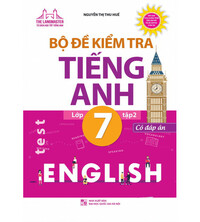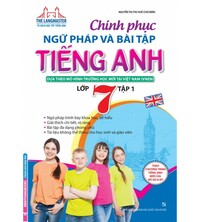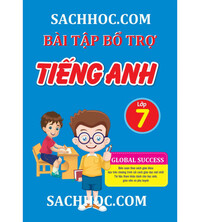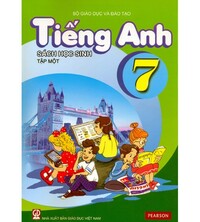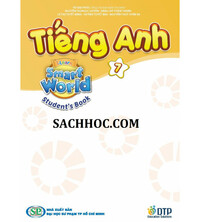Tiếng Anh 7 Unit 8 Lesson 2
a. Fill in the blanks. Listen and repeat.b. In pairs: Talk about festivals and holidays in your country and the traditions to celebrate them.a. Listen to two friends talking about traditions. What are they celebrating?b. Now, listen and fill in the blanks.c. In pairs: Which of these Spanish or Scottish traditions do you think is the most interesting? a. Rewrite the sentences using (not) as...as...b. Unscramble the sentences. c. Write sentences using the table.d. In pairs: Compare Christmas tr
a
a. Fill in the blanks. Listen and repeat.
(Điền vào chỗ trống. Nghe và lặp lại.)
|
exchange tradition midnight wish greeting celebrate (trao đổi) (truyền thống) (nửa đêm) (mong ước) (lời chào) (kỷ niệm) |

Lời giải chi tiết:
|
2. midnight |
3. wish |
4. tradition |
5. greeting |
6. exchange |
b
b. In pairs: Talk about festivals and holidays in your country and the traditions to celebrate them.
(Theo cặp: Nói về lễ hội và kỳ nghỉ ở đất nước bạn và truyền thống kỷ niệm chúng.)
We celebrate Lunar New Year. We wish each other a happy and lucky year.
(Chúng tôi kỷ niệm Tết Nguyên Đán. Chúng tôi cầu chúc cho mỗi người một năm mới hạnh phúc và may mắn.)
a
a. Listen to two friends talking about traditions. What are they celebrating?
(Nghe 2 người bạn đang nói về truyền thống. Họ đang kỷ niệm cái gì?)
1. Christmas 2. New Year's Eve
b
b. Now, listen and fill in the blanks.
(Bây giờ, nghe và điền vào chỗ trống.)
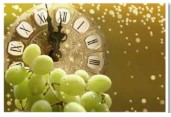
1. In Spain, people eat ___________grapes at midnight to bring good luck.
2. Spanish people believe that you should make the first step with your_______ foot.
3. In Scotland, the first person to enter a house should bring coal, _______La coin, and a drink.
4. Scottish people believe that the drink will bring you__________.
c
c. In pairs: Which of these Spanish or Scottish traditions do you think is the most interesting?
(Theo cặp: Bạn nghĩ truyền thống của Tây Ban Nha hay truyền thống của Scotland thú vị nhất?)
|
Conversation Skill (Kỹ năng hội thoại) Showing interest (thể hiện sự quan tâm đến) To show you are listening to someone, say: (để thể hiện bạn đang nghe ai đó, nói: ) Wow. That's interesting. (điều đó thật thú vị.) Listen and repeat. (Nghe và lặp lại.) |
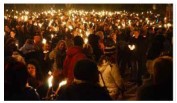
a
a. Rewrite the sentences using (not) as...as...
(Viết lại câu sử dụng cấu trúc (not) as...as...)
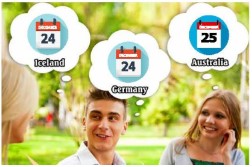
Girl 1: In Iceland, we celebrate Christmas on December twenty-fourth.
(Ở Iceland, chúng tôi tổ chức Giáng sinh vào 24/12.)
Boy: That's like Germany.
(Vậy thì giống nước Đức.)
Girl 2: That's different fromAustralia.
(Vậy thì khác với nước Úc.)
b
b. Unscramble the sentences.
(Sắp xếp câu.)
1. dessert/from/different/is/Japan's./Christmas/Germany's
Germany's Christmas dessert is different from Japan's .
2. Brazil's/costume/Years/is/from/different/Vietnam's./New
______________________________________________________.
3. Vietnamese/Koreans/visit/Like/people,/temples.
______________________________________________________.
4. Australians/gifts/Americans/Like/exchange/Christmas. /at
_______________________________________________________.
5. Halloween/in/from/Halloween/the/in/different/is/Mexico./US
________________________________________________________.
6. children/Like/French/children,/Easter./chocolate/at/English/get/eggs
_________________________________________________________.
Lời giải chi tiết:
2. Brazil’s New Years costume is different from Vietnam’s.
(Trang phục Tết của Brazil thì khác với Việt Nam.)
3. Like Vietnamese people, Koreans visit temples.
(Giống như người Việt, người Hàn đến thăm chùa.)
4. Like Australians, Americans exchange gifts at Christmas.
(Giống như người Úc, người Mỹ trao đổi quà vào Giáng sinh.)
5. Halloween in the US is different from Halloween in Mexico.
(Halloween ở Mỹ thì khác với Halloween ở Mexico.)
6. Like French children, English children get chocolate eggs at Easter.
(Giống như trẻ em Pháp, trẻ em nước Anh nhận được trứng sô cô la vào lễ Phục sinh.)
c
c. Write sentences using the table.
(Viết câu sử dụng bảng.)
|
CHRISTMAS TRADITIONS |
|
|
Australia (Úc) |
• Decorate with lights and trees (trang trí với đèn và cây) • Eat cold meats or seafood (ăn thịt đông hoặc hải sản) • Exchange gifts with family and friends (trao đổi quà với gia đình và bạn bè) • Celebrate on Christmas Day (tổ chức vào ngày Giáng sinh) |
|
Italy (Ý) |
• Decorate with lights and trees (trang trí với đèn và cây) • Eat seafood (ăn hải sản) • Exchange gifts with family and friends (trao đổi quà với gia đình và bạn bè) • Celebrate from Dec 24th to 26th (tổ chức vào ngày 24- 26/12) |
|
Japan (Nhật Bản) |
• Decorate with lights (trang trí với đèn) • Eat fried chicken (ăn gà chiên) • Exchange gifts with lover (trao đổi quà với người yêu) • Celebrate on Christmas Eve (tổ chức vào lễ Giáng sinh) |
1. Italians decorate with lights and trees. That's like Australians.
2. Christmas meal in Japan_________Italy.
3. Australians exchange____________________.
That's _____________________Japanese people.
4. Italy celebrates Christmas from____________.
______________________________Australia.
5. Italians exchange_______________________.
__________________ Australians.
6. Australia celebrates Christmas on__________.
That's____________ Japan.
7. Christmas meal in Italy_________________Australia.
Lời giải chi tiết:
|
2. has fried chicken. That’s different from |
|
3. gifts with family and friends./ different from |
|
4. Dec 24th to 26th / That’s different from |
|
5. gifts with family and friends. / That’s like |
|
6. Christmas Day / like |
|
7. is different from |
d
d. In pairs: Compare Christmas traditions in your country with one of the countries in the table in task c.
(Theo cặp: So sánh truyền thống lễ Giáng sinh ở đất nước bạn với một trong những đất nước ở bảng phần c.)
Lời giải chi tiết:
On Christmas day, my country decorate with lights and trees. That’s like Japan.
(Vào ngày lễ Giáng sinh, quê tôi trang trí đèn và cây. Điều đó giống với Nhật Bản.)
We eat traditional meals with family. That’s different from Japan.
(Chúng tôi ăn bữa ăn truyền thống với gia đình. Điều đó khác với Nhật Bản.)
We celebrate from Dec 24th to 26th. . That’s different from Japan.
(Chúng tôi tổ chức từ 24/12- 26/12. Điều đó khác với Nhật Bản.)
a
a. Focus on the /I/ sound.
(Chú ý cách phát âm /I/.)
b
b. Listen to the words and focus on the underlined letters.
(Nghe từ và chú ý những chữ được gạch chân.)
midnight wish Christmas festival
(nửa đêm) (mong ước)(Giáng sinh)(lễ hội)
c
Listen and cross out the word that doesn't follow the note in "a."
(Nghe và loại bỏ từ không theo ghi chú ở phần a.)
tradition gift light
(truyền thống) (quà) (đèn)
d
d. Read the words with the sound noted in "a." to a partner.
(Đọc lại những từ với phát âm được ghi chú ở phần a cùng bạn đồng hành.)
Câu 14
a. Take turns comparing the traditions in different countries.
(Lần lượt so sánh truyền thống của các nước khác nhau.)
Germans put up trees on Christmas, like British people.
(Người Đức dựng cây vào Giáng sinh giống với người Anh.)
In the USA, the Easter Bunny brings eggs at Easter. That's different from France. Bells bring eggs in France.
(Ở Mỹ, Chú thỏ Phục sinh mang trứng vào lễ Phục sinh. Điều đó khác với nước Pháp. Chuông mang trứng ở Pháp.)
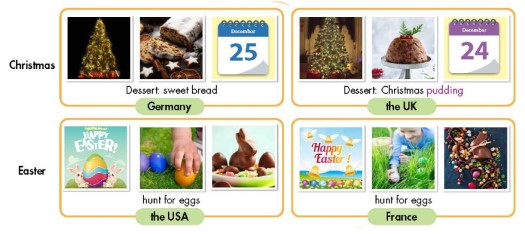
Lời giải chi tiết:
At Christmas, Germans eat sweet bread for dessert. That’s different from the UK. In the UK, they eat Christmas pudding for dessert.
(Vào Giáng sinh, người Đức ăn bánh ngọt cho bữa tráng miệng. Điều đó khác với vương quốc Anh. Ở vương quốc Anh, họ ăn bánh pudding Giáng sinh.)
On Easter day, the USA’s people hunt for eggs, like French.
(Vào ngày lễ Phục sinh, người Mỹ đi săn trứng, giống với người Pháp.)
a
a. In pairs: Take turns comparing how different your traditions are to the traditions in South Korea and Mongolia.
(Theo cặp: Lần lượt so sánh sự khác nhau giữa truyền thống ở nước bạn với truyền thống các nước Hàn Quốc và Mông Cổ.)
Mid-Autumn Festival lasts three days in South Korea. That's different from Vietnam. We celebrate for...
(Tết Trung thu kéo dài 3 ngày ở Hàn Quốc. Điều đó khác với Việt Nam. Chúng tôi kỷ niệm...)
|
Mid-Autumn Festival in South Korea (Tết Trung thu ở Hàn Quốc) |
Lunar New Year in Mongolia (Tết Nguyên Đán ở Mông Cổ) |
|
Dates: 14th to 16th of the eighth month of Lunar calendar (Ngày: 14 - 16/8 âm lịch) |
Dates: first three days of Lunar calendar (Ngày: 3 ngày đầu tiên của lịch âm) |
|
Traditions (truyền thống): • visit family (thăm gia đình) • wear traditional clothes (mặc trang phục truyền thống) • exchange gifts with family and friends (trao đổi quà với gia đình và bạn bè) • eat half-moon rice cakes (ăn bánh trung thu) • play traditional games and watch traditional dance greeting to the elders and sports (chơi các trò chơi truyền thống và xem lời chào khiêu vũ truyền thống cho người lớn tuổi và thể thao) |
Traditions (truyền thống): • clean houses before the new year (dọn dẹp nhà trước năm mới) • have a big dinner the night before (có một bữa tối thịnh soạn vào buổi tối hôm trước) • wear traditional clothes (mặc trang phục truyền thống) • visit family on the first day, perform a special (thăm gia đình vào ngày đầu tiên, thực hiện một chương trình đặc biệt) • have milk tea and a dish called "buuz" (có trà sữa và một bữa ăn được gọi là “buuz”) |
Lời giải chi tiết:
Mid-Autumn Festival lasts three days in South Korea. That's different from Vietnam. We celebrate from 14th to 15th of the eighth month of Lunar calendar.
(Tết Trung thu kéo dài 3 ngày ở Hàn Quốc. Điều đó khác với Việt Nam. Chúng tôi tổ chức từ 14-15/8 âm lịch.)
South Korean eat half-moon rice cakes, play traditional games and watch traditional dance greeting to the elders and sports. That’s like Vietnam.
(Người Hàn ăn bánh trung thu, chơi các trò chơi truyền thống và xem lời chào khiêu vũ truyền thống cho người lớn tuổi và thể thao. Điều đó giống với Việt Nam.)
Lunar New Year lasts first three days of Lunar calendar in Mongolia, like Vietnam.
(Tết Nguyên Đán kéo dài 3 ngày đầu tiên âm lịch ở Mông Cổ, giống với Việt Nam.)
Mongolian clean houses before the new year, have a big dinner the night before, wear traditional clothes. That’s like Vietnam.
(Người Mông Cổ dọn dẹp nhà trước năm mới, có một bữa tối thịnh soạn vào buổi tối hôm trước, mặc trang phục truyền thống. Điều đó giống với Việt Nam.)
Mongolian have milk tea and a dish called "buuz". That’s different from Vietnam.
(Người Mông Cổ có trà sữa và một bữa ăn được gọi là “buuz”. Điều đó khác với Việt Nam.)
b
b. What are some other traditions to celebrate Lunar New Year and Mid-Autumn Festival in your family?
(Một số truyền thống khác để đón Tết Nguyên đán và Tết Trung thu trong gia đình bạn là gì?)
My family goes to our favorite coffee shop.
(Gia đình tôi đi đến quán cà phê yêu thích.)
My family always goes to Vũng Tàu for Tết.
(Gia đình tôi luôn đi Vũng Tàu vào dịp Tết.)
Lời giải chi tiết:
At the Mid-Autumn Festival, my family goes to the park.
(Vào tết Trung thu, gia đình tôi đi công viên.)
My family goes to Nha Trang for Tet.
(Gia đình tôi đi Nha Trang vào dịp Tết.)
Search google: "từ khóa + timdapan.com" Ví dụ: "Tiếng Anh 7 Unit 8 Lesson 2 timdapan.com"
